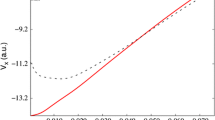Abstract
Pseudopotential theory is combined with the Hartree-Fock and natural expansion method to calculate the molecular constantsD e, Re andk e for Na2, K2, NaCs and BeH2. We treat these molecules as two- or four-electron problems respectively in the pseudopotential field of their cores. We then analyze the energies and wave functions in terms of the contributions of the different natural orbitals to the correlation energy. The calculated equilibrium distances agree well with the experimental ones. The dissociation energies are in better agreement with experiment than those of previous calculations.
Резюме
Псевдопотенциальная теория комбинируется с методом Харти-фока и методом естественного разложения в ряд с целью определения молекулярных постоянныхD e, Re иk e для Na2, K2, NaCs и BeH2. Эти молекулы рассматривались как двух- и четырехэлектронные проблемы соответственно в псевдопотенциальном поле своих атомных остатков. Далее были анализированы энергии и волновые функции с точки зрения взноса различных натуральных орбит в корреляционную энергию. Вычисленные расстояния равновесия хорошо согласуутся с экспериментальными данными Соответствие диссоциационных энергий с экспериментальными данными лучше, чем в педыдущих вычислениях.
Similar content being viewed by others
References
J. H. van Vleck andA. Sherman, Rev. Mod. Phys.,7, 167, 1935.
H. Hellmann, Acta Physicochim. USSR,1, 913, 1935;4, 225, 1936;P. Gombás, Z. Physik,94, 472, 1935.
P. Gombás, Pseudopotentiale, Springer-Verlag, Wien-New York, 1967.
H. Preuss, Z. Naturforschung,10 a 365, 1955.
I. Szasz andG. McGinn, J. Chem. Phys.,42, 2363, 1965.
I. Szasz andG. McGinn, J. Chem. Phys.,45, 2898, 1966.
I. Szasz andG. McGinn, J. Chem. Phys.,47, 3495, 1967.
I. Szasz andG. McGinn, J. Chem. Phys.,48, 2997, 1968.
R. G. Parsons andV. F. Weisskopf, Z. Physik,202, 492, 1967.
Austin andH. Heine, J. Chem. Phys.,45, 928, 1966.
W. Kutzelnigg, R.-J. Koch andW. A. Bingel, Chem. Phys. Letters,2, 197, 1968.
J. G. Phillips andL. Kleinmann, Phys. Rev.,116, 287, 1959;118, 1351, 1960.
A. U. Hazi andS. A. Rice, a) J. Chem. Phys.,48, 495, 1968; b) J. Chem. Phys.,45, 3004, 1966; c) J. Chem. Phys.,47, 1125, 1967.
I. V. Abarenkov andV. Heine, Phil. Mag.12, 529, 1965.
G. J. Iafrate, J. Chem. Phys.,45, 1072, 1966; J. Chem. Phys.,46, 728, 1967.
M. N. Cohen andV. Heine, Phys. Rev.,122, 1821, 1961.
W. Kutzelnigg a) Theoret. Chim. Acta,1, 327, 1963; b) J. Chem. Phys.,40, 3640, 1964. c)R. Ahlrichs andW. Kutzelnigg, J. Chem. Phys.,48, 1829, 1967.
J. R. Hoyland, J. Chem. Phys.,40, 3540, 1964.
McGoldberg andJ. R. Ritter, J. Phys. Chem.,71, 3111, 1967.
S. Peyerimhoff, R. F. Buenker andL. C. Allen, J. Chem. Phys.,45, 734, 1966.
R. Ahlrichs andW. Kutzelnigg, Theoret. chim. Acta,10, 377, 1968.
W. H. E. Schwarz, Theoret. chim. Acta,11, 307, 1968;11, 377, 1968, Z. Physik,214, 149, 1968.
W. A. Harrison, Pseudopotentials in the theory of metals, W.A. Benjamin, Inc. New York, 1966.
H. Preuss, Z. f. Naturforsch.,10 a, 365, 1955.
P. Gombás, Theoret. chim. Acta,5, 112, 1966;5, 127, 1966;G. J. Iafrage, J. Chem. Phys.,45, 1072, 1966;T. C. Chen, J. Chem. Phys.,29, 347, 1958.
W. Neumann andH. Pauly, Phys. Rev Letters,20, 357, 1968.
CH. Schlier andE. Vietzke, Chem. Phys. Letters,3, 250, 1969.
L. R. Kahn andW. A. Goddard III., Chem Phys. Letters,2, 667, 1968.
A. C. Wahl: private communications.
G. Das, J. chem. Phys.,44, 87, 1966.
Author information
Authors and Affiliations
Additional information
Dedicated to ProfP. Gombás on his 60th birthday.
Rights and permissions
About this article
Cite this article
Bingel, W.A., Koch, R.J. & Kutzelnigg, W. Simulation of the influence of core electrons by a pseudopotential II. Acta Physica 27, 323–344 (1969). https://doi.org/10.1007/BF03156756
Received:
Issue Date:
DOI: https://doi.org/10.1007/BF03156756




